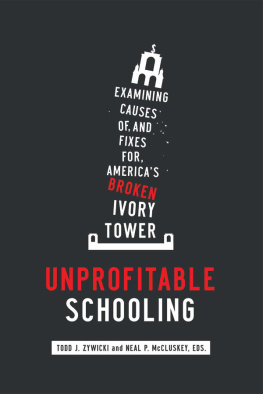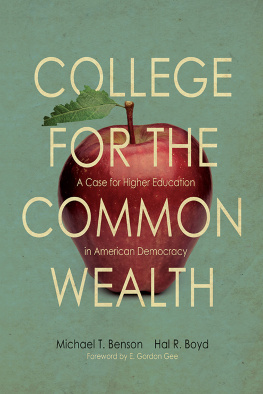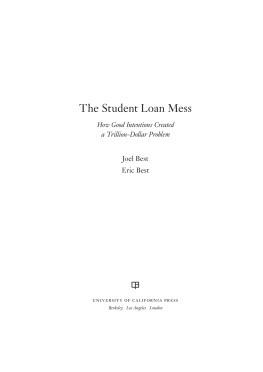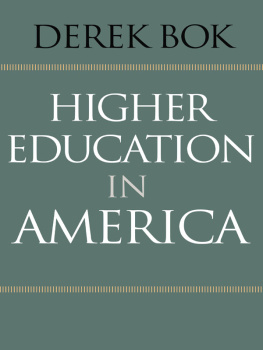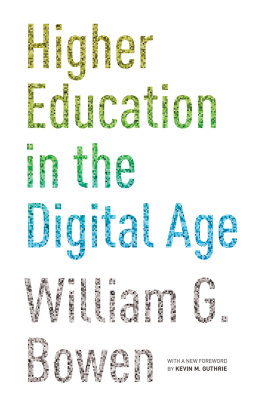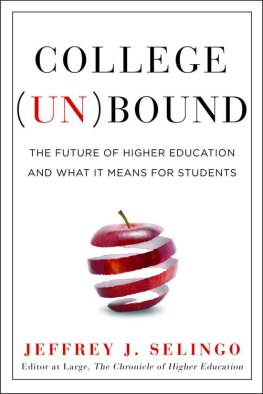Copyright 2019 by the Cato Institute.
All rights reserved.
Jacket design: Spencer Fuller, Faceout Studio.
Printed in the United States of America.
Zywicki, Todd J., editor. | McCluskey, Neal P., 1972- editor.
Unprofitable schooling : examining causes of, and fixes for, Americas broken ivory tower / Todd J. Zywicki and Neal P. Mccluskey, eds.
page cm
Washington, D.C.: Cato Institute, 2019.
Includes bibliographical references.
ISBN 9781948647052 (ebook) | ISBN 9781948647045 (alk. paper)
1. Higher education and state--United States. 2. Federal aid to higher education--United States. 3. College costs--United States. 4. Education, Higher--Economic aspects--United States. 5. For-profit universities and colleges--United States.
CONTENTS
Todd J. Zywicki and Neal P. McCluskey
PART I
H ISTORICAL P ERSPECTIVES ON C OMPETITION AND G OVERNMENT S R OLE IN H IGHER E DUCATION
CHAPTER ONE
What Really Spurred the Morrill Act?
Jane Shaw Stroup
CHAPTER TWO
The Morrill Land-Grant Act: Fact and Mythology
Richard K. Vedder
CHAPTER THREE
Accreditation: Market Regulation or Government Regulation Revisited?
Joshua C. Hall
PART II
T HE C URRENT S TATE OF H IGHER E DUCATION IN A MERICA
CHAPTER FOUR
Understanding the Runaway Tuition Phenomenon: A Soliloquy with Footnotes
Daniel D. Polsby
CHAPTER FIVE
Academic Tenure and Governance
Roger E. Meiners
CHAPTER SIX
The Changing of the Guard: The Political Economy of Administrative Bloat in American Higher Education
Todd J. Zywicki and Christopher Koopman
CHAPTER SEVEN
The Senseless Monstrosity in Our Path: Academic Bargains and the Rise of the American University
Scott E. Masten
PART III
C OMPETITION IN H IGHER E DUCATION
CHAPTER EIGHT
All Education Is For-Profit Education
Henry G. Manne
CHAPTER NINE
Assessing For-Profit Colleges
Jayme S. Lemke and William F. Shughart II
CHAPTER TEN
Public Policy and the Future of For-Profit Higher Education
Michael E. DeBow
CHAPTER ELEVEN
Nonprofit and For-Profit Enterprise in Health Care: Birds of a Feather?
David A. Hyman
INDEX
AACSBAssociation to Advance Collegiate Schools of Business
AAUAssociation of American Universities
AAUPAmerican Association of University Professors
APSCUAssociation of Private Sector Colleges and Universities
CFPBConsumer Financial Protection Bureau
CHEACouncil for Higher Education Accreditation
EDUnited States Department of Education
EDMCEducation Management Corporation
FAFSAFree Application for Federal Student Assistance
FTEfull-time equivalent
GDPgross domestic product
GEgainful employment
HEAHigher Education Act
HELPSenate Committee on Health, Education, Labor and Pensions
HMOhealth maintenance organization
IPEDSIntegrated Postsecondary Education Data System
IRBinstitutional review board
MCOmanaged care organization
NCANorth Central Association
PEIprestige, excellence, and influence
PPACAPatient Protection and Affordable Care Act
Todd J. Zywicki and Neal P. McCluskey
Lets start with some basic facts:
- Inflation-adjusted undergraduate tuition and fees at public four-year colleges have roughly tripled over the past 30 years. That does not include room and board.
- For students who entered college in 2010, the six-year completion rate for four- and two-year programs was only 54.8 percent.
- The percentage of undergraduate students ages 18 to 24 in their fourth (senior) year or above who ever received student loans rose from 50.5 percent in the 198990 school year to 67.7 percent in 201112. The average, inflation-adjusted cumulative loan amount ballooned from $15,400 to $26,600. That excludes Parent PLUS loans, which parents take out on their childrens behalf, which grew even faster and higher.
- As of January 1, 2016, 43 percent of federal student loan borrowers were either behind on their repayments or in a program allowing postponement of payments.
- The National Assessment of Adult Literacy, conducted in 1992 and 2003, showed that the percentage of adults with educational attainment topping out at a bachelors degree that were proficient prose readersable to read and comprehend writings such as news articles or brochuresdropped from 40 to 31. For document literacythe ability to read and use a tax form or food labelthe proficiency rate fell from 37 to 25. For people holding advanced degrees, the percentage scoring proficient fell from 51 to 41 in prose and from 45 to 31 percent in document literacy.
- Time spent studying by full-time students dropped from about 25 hours per week in 1961 to 20 hours in 1980, to 13 hours in 2003.
- National Center for Education Statistics data show that the inflation-adjusted earnings of full-time year-round workers ages 25 to 34 with degrees fell between 2000 and 2015. The annual earnings for the median such person whose top attainment was a bachelors degree was $55,640 in 2000, dropping to $50,630 in 2015. For someone with a postgraduate degree, earnings dipped from $66,910 to $60,760.
Collectively, these figures paint a bleak, frustrating picture of ballooning costs and declining returns in higher education. Coupled with major psychological milestones passed in recent yearsin 2010, total student debt surpassed total credit card debt for the first time, and in 2012 total student debt broke the $1 trillion barriera lot of people have been asking, increasingly aloud: What is wrong with higher education? Is college worth all it costs? How can I know if Im getting ripped off?
Whatever answers Americans are coming up with, they apparently are not on the side of academia. In September 1985, an already low 39 percent of survey respondents agreed with the statement, College costs in general are such that most people are able to afford to pay for a college education. By 2011 that had dropped to 22 percent.
Over the past several years, members of the public have been offered many answers to their pressing questions about what is happening in higher education. There have been those who have said that, yes, there are some troubles, but on the whole everything is functioning pretty much as it should. As economist Sandy Baum has written, college does not always pay off immediately and does not pay off for everyone. The visibility of the minority of students for whom the decision to go to college (or at least go to their particular college) turned out to be questionable creates an exaggerated impression of the risks.

